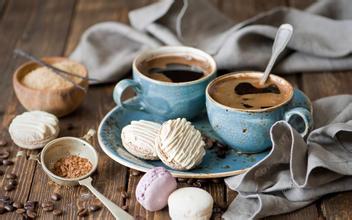The short story behind the coffee to explore the mysteries of the coffee world
Coffee, from the day it was discovered, is full of mysterious and intoxicating power. For hundreds of years, the variety of coffee, the way of baking, the type of blending, and the place where we drink coffee have all undergone earth-shaking changes, giving too many additional meanings. Back to the coffee itself, let's tell his story.
1. Espresso Espresso
Espresso is a high concentration coffee that originated in Italy at the beginning of the 20th century. It originally means concentrated in Italian, emphasizing the strong taste and purity of this coffee. Espresso is usually packed in small coffee cups and drunk by Italians. They all pick up the cup and drink it. With such a strong taste of coffee, only an unrestrained Italian can accept him in this way.
Espresso seems simple, but as it means, it is a condense of coffee culture. Even the same kind of coffee beans, due to the different degree of grinding, water temperature, brewing techniques, the final taste is also diverse, this is his charm. He is also the basis of all kinds of coffee in modern times.
2. Latte
Espresso 1/3, hot milk 2/3, the perfect combination of the two is a creamy latte.
Latte (Latte), which means milk in Italian. When lattes became popular in Britain and the United States in the mid-19th century, they were used to refer to coffee with milk. In Italy, if you want to order a latte, you should say caff è latte instead of Latte, otherwise you will end up with a glass of milk. Latte is especially suitable for people who don't like the sour taste of coffee because of its high milk content.
3. Cappuccino-the feast of taste
Cappuccino: 1/3 espresso, 1/3 hot milk, plus 1/3 bubbles.
Cappuccino is considered to represent the traditional Italian coffee blending style, although it is ultimately a blend of Italian and American espresso. It is said that the monks of St. Franciscans wore brown robes and pointed hats after 1525. When they spread to Italy, the locals named their clothes cappuccino "Cappuccino". At the end of the 17th century, a monk found a pile of coffee beans on the battlefield of the Battle of Vienna. But the coffee made from these beans tastes so strong that Europeans add cream and honey to it. Coincidentally, the coffee made in this way was similar in color to the monk's robe, and then it was named after the Taoist robe.
4 、 Cortado
Cortado is obtained by adding a small amount of warm milk to the Espresso. Pour Espresso first, and then pour the milk in the right order. The ideal ratio of coffee to milk should be between 2: 1 and 1: 1.
Cortado is popular in Spain, Portugal and Latin America, and people like to drink it in the afternoon. He has much less milk than a latte, masking the acidity of some coffee without diluting the unique taste of coffee. But here we want to distinguish between cortado and Italian black sugar macchiato. Macchiato is traditionally listed in espresso with a small amount of foam or hot milk with a proportion of less than 1. Although 1: 1 is used in the contemporary United States, there are more milk bubbles than Macchiato, like a small latte. Cortado is more like a cappuccino with less foam than Macchiato.
5. Mocha (Mocca)
Mocha evolved from a latte and was invented by Americans inspired by chocolate coffee in Turin. Like a latte, mocha is usually 1/3 espresso with 2/3 hot milk, with certain chocolates, such as cocoa powder or chocolate syrup, and sometimes dark chocolate or milk chocolate. Like the cappuccino, the latte has an attractive layer of milk foam, sometimes replaced with cream to increase the taste, followed by cinnamon, cocoa powder, and sometimes marshmallows. The taste is very rich, is the coffee in the mash-up master.
The name Mocha Coffee comes from Mocha, a small town on the Red Sea in Yemen. This place monopolized the export of coffee in the 15th century, which had a particular impact on the coffee trade sold to the Arabian Peninsula. Mocha is also a "chocolate-colored" coffee bean (from Yemeni mocha), which makes people associate coffee with chocolate and develop chocolate espresso drinks. In Europe, "mocha coffee" may refer either to this drink or simply to coffee made from mocha beans.
6. Bombon coffee
Bombon is made from espresso and sweetened condensed milk in a ratio of 1 to 1. The step is to pour espresso first, then add condensed milk. The process of pouring in is very enjoyable. the milk slowly drowns the espresso, watching the color of the espresso stirred, producing a rich texture, and then returning to calm to form a distinct layer. When drinking, stir with a spoon to blend condensed milk and coffee.
Bombon was popular in Valencia, Spain, and then swept the country. Spaniards are enthusiastic, optimistic, unrestrained and practical. Condensed milk, strong sweet fragrance, with the mellow bitterness of coffee, rich and warm, just like the Spanish nature to pursue a rich and colorful life.
7. Frappuccino coffee
Frappuccino, a combination of frappe and cappuccino, is an iced coffee. Choose a medium-bodied Latin American comprehensive coffee, which is roasted to form a slightly darker color than the concentrated roasted coffee. The slightly smoky sweet aroma of Italian roasted coffee is mixed with silky milk and the right amount of sugar, making it an irresistible delicious experience.
Frappuccino was developed and named by George Howell's Massachusetts coffee chain. Starbucks, an international coffee chain, bought the store in 1994 and acquired the right to use the drink, and the Frappuccino went public soon.
8. Affogato Coffee
Affogato is an alcoholic beverage. A spoonful of vanilla ice cream, a cup of hot espresso, and some Italian bitter apricot or other spirits, these seemingly very different ingredients, together, have a wonderful chemical reaction.
Watching ice cream melt in hot coffee and slowly mix with coffee, appreciation is also a work of art.
9. Bicerin coffee
Bicerin is a traditional hot coffee condiment, native to Turin, Italy, made from a mixture of espresso, cocoa pulp and whole milk or cream, usually in a small round cup, very beautiful.
Bicerin has been popular since the 18th century, and the French writer Dumas praised it in 1852. The most moving thing about Bavareisa is that its three ingredients are not simply integrated, but are divided into layers in the cup. The colors of the three ingredients are from dark to light, from top to bottom, from smooth and delicate to sweet, and finally bitter to sweet, multi-level taste enjoyment.
Source: you and my hot mom gang
Important Notice :
前街咖啡 FrontStreet Coffee has moved to new addredd:
FrontStreet Coffee Address: 315,Donghua East Road,GuangZhou
Tel:020 38364473
- Prev

The little secret of the success of a cafe-- storefront design (wooden chapter)
Wood products can be integrated with many design styles, such as primitive wild type, Nordic modern type, American rough type, natural soft type and so on. And the design of the cafe. Wood is natural. It has unique texture and structure, and its texture, ring and color can give people a feeling of returning to nature and returning to nature. It is deeply loved by the public and has irreplaceable nature.
- Next

The menu of the cafe is so designed that it is easiest to inspire and establish people's impression of the theme of the store.
Menu is the object that we must pay attention to before we enter the store for consumption. it is generally in a prominent position and is most likely to stimulate and establish people's impression of the theme of the store. Coffee shop as a leisure place for people to pursue the quality of life, the layout of every inch of space can not be easily ignored. Generally speaking, the most common coffee shop menus are communicated through paper or blackboard as a medium.
Related
- What brand of black coffee is the most authentic and delicious? what are the characteristics of the flavor of the authentic Rose Summer Black Coffee?
- Introduction to the principle and characteristics of the correct use of mocha pot A detailed course of mocha pot brewing coffee is described in five steps.
- Which is better, decaf or regular coffee? how is decaf made?
- How much is a bag of four cat coffee?
- How about four Cat Coffee or Nestle Coffee? why is it a cheap scam?
- Which is better, Yunnan four Cats Coffee or Nestle Coffee? How about cat coffee? is it a fake scam? why is it so cheap?
- How about Cat Coffee? what grade is a hoax? which instant coffee tastes better, four Cat Coffee, Nestle Coffee or G7 coffee?
- Process flow chart of coffee making-Starbucks coffee making process what coffee tastes good at Starbucks
- The top ten best coffee beans in the world Rose summer coffee or Tanzanian coffee tastes good
- Yunnan four cat coffee is good to drink?_four cat coffee is a big brand? four cat blue mountain coffee is fake?

